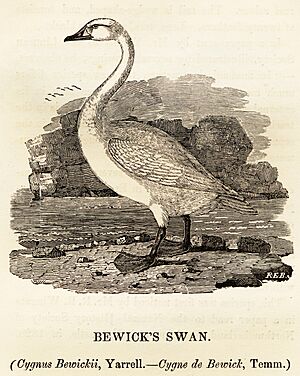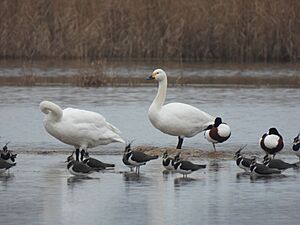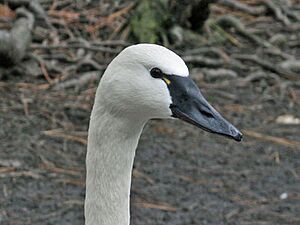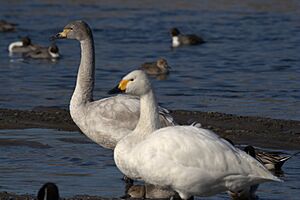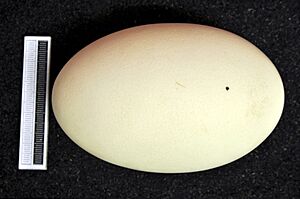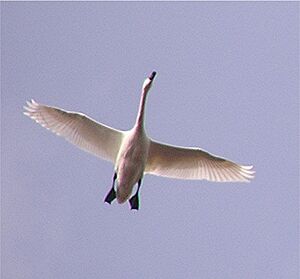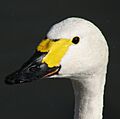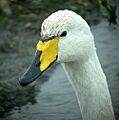Tundra swan facts for kids
Quick facts for kids Tundra swan(Bewick's swan/whistling swan) |
|
|---|---|
 |
|
| Adult Bewick's swan, Cygnus columbianus bewickii | |
| Conservation status | |
| Scientific classification | |
| Genus: |
Cygnus
|
| Species: |
columbianus
|
| Subspecies | |
|
C. c. bewickii (Yarrell, 1830), Bewick's swan |
|
 |
|
| Synonyms | |
|
|
The tundra swan (Cygnus columbianus) is a smaller type of swan found across the northern parts of the world. There are two main kinds of tundra swans. They are often seen as the same species, but sometimes they are called two different species. These are the Bewick's swan (Cygnus bewickii) from Europe and Asia, and the whistling swan (C. columbianus) from North America.
The Bewick's swan was named in 1830 by William Yarrell. He named it after Thomas Bewick, an artist famous for his bird and animal drawings. The name Cygnus is Latin for "swan". The name columbianus comes from the Columbia River in North America.
Contents
What Does a Tundra Swan Look Like?
Tundra swans are the smallest swans in the northern parts of the world. They are about 115 to 150 centimeters (45 to 59 inches) long. Their wings can spread from 168 to 211 centimeters (66 to 83 inches). They weigh between 3.4 and 9.6 kilograms (7.5 to 21.2 pounds).
Adult swans are completely white. They have black feet and a mostly black bill. There is a thin pink line along their mouth. Depending on the type, they might have some yellow near the base of their bill. Their eyes are dark brown. If they live in water with a lot of iron, their head and neck feathers can look golden or rusty. Female swans (called pens) are a bit smaller than male swans (called cobs), but they look the same.
Young swans are a mix of white and dull grey feathers. Their head and upper neck are often light grey. By their first summer, they are mostly white. By their second winter, they get their adult feathers. Their bills are black with a large pink patch near the base. Their feet are dark grey with a pinkish color. Very young swans, called cygnets, are silvery grey on top and white underneath.
Bewick's Swan: Size and Bill Pattern
Bewick's swans are the smaller type. They weigh about 3.4 to 7.8 kilograms (7.5 to 17.2 pounds). They are 115 to 140 centimeters (45 to 55 inches) long.
Bewick's swans look similar to the whooper swan. However, Bewick's swans are smaller and have shorter necks. Their heads are also more rounded. Their bill patterns vary, but they always have more black than yellow. The yellow part at the base of the bill has a blunt front edge. Whooper swans have more yellow than black on their bills, and the yellow part usually has a pointed front edge. Each Bewick's swan has a unique bill pattern. Scientists often draw these patterns to help study the birds.
Whistling Swan: Size and Bill Pattern
Whistling swans weigh about 4.3 to 9.5 kilograms (9.5 to 21 pounds). They are 119 to 150 centimeters (47 to 59 inches) long.
Whistling swans are larger than Bewick's swans. Their bills are mostly black, with only a small, often hard-to-see, yellow spot at the base. They are different from the trumpeter swan of North America. Trumpeter swans are much larger and have very long bills that are completely black, except for a pink line along the mouth.
Sometimes, tundra swans can have different colors on their bills, like more or less yellow, or even pink instead of yellow or black. This is especially true for Bewick's swans. Their small size and short neck make them look like a large white goose.
Tundra Swan Calls
Tundra swans make high-pitched honking sounds. They sound a bit like a black goose. They are very noisy when they are feeding in groups during winter. If another swan arrives or leaves, the others will make loud, excited calls.
Even though it's called the "whistling swan," its calls on the ground are not really whistles. They are also not very different from Bewick's swan calls. When Bewick's swans fly, they make a soft, low bark, like bow-wow.... Whistling swans make a higher-pitched, three-part bark, like wow-wow-wow when flying.
Where Do Tundra Swans Live?
As their name suggests, tundra swans breed in the cold tundra regions of the Arctic. They live in shallow pools, lakes, and rivers. Unlike mute swans, tundra swans are migratory birds. This means they fly long distances between their breeding and winter homes.
In winter, both types of swans live in grasslands and marshlands, often near the coast. They like to visit farm fields after harvest to eat leftover grains. When they migrate, they might stop at mountain lakes. These birds can fly very high, sometimes up to 8 kilometers (5 miles) high, in a V formation.
Bewick's Swan Migration
Bewick's swans breed across the coastal areas of Siberia, from the Kola Peninsula to the Pacific Ocean. They arrive at their breeding grounds around mid-May and leave for winter around the end of September.
Swans from western Siberia fly over the White Sea and Baltic Sea. They winter in Denmark, the Netherlands, and the British Isles. Many are seen in nature reserves there.
Bewick's swans from eastern Russia fly through Mongolia and northern China. They spend winter in coastal areas of Korea, Japan, and southern China. Some even go as far as Taiwan. A few birds from central Siberia winter in Iran, near the Caspian Sea.
They start arriving in their winter homes around mid-October. However, many spend weeks resting in favorite spots. They might not reach their final wintering areas until November or even January. They begin to leave for their breeding grounds in mid-February.
Whistling Swan Migration
Whistling swans breed in the coastal plains of Alaska and Canada. They leave for their winter homes around October. They arrive in their winter areas by November or December.
Swans from western Alaska winter along the Pacific coast, from southern Alaska to California. They often move inland to places like the Central Valley to feed. Some even fly over the Rocky Mountains to winter in places like Utah, Texas, and northern Mexico.
Swans that breed along the Arctic Ocean coast fly through Canada and the Great Lakes region. They winter on the Atlantic coast of the United States, mainly from Maryland to North Carolina. Some go as far south as Florida. Whistling swans start leaving for their breeding grounds in mid-March and arrive by late May.
Life Cycle and Behavior
What Do Tundra Swans Eat?
In summer, tundra swans mainly eat water plants. They get these plants by putting their heads underwater or by tipping their bodies upside down while swimming. They also eat some grass on land. At other times of the year, they eat leftover grains and other crops like potatoes from farm fields after harvest. Tundra swans usually feed during the day.
During the breeding season, they protect their territory and can be aggressive towards animals that come too close. Outside of breeding season, they are more social and live in groups.
Who Are Their Predators?
Healthy adult tundra swans have few natural predators. The Arctic fox can be a threat to female swans, their eggs, and young cygnets. Adult swans usually stand up to foxes and scare them away. However, sometimes foxes are successful.
Surprisingly, brown bears are also serious predators for swan nests. They are a main reason why nests fail in some areas. Other animals that might eat eggs or young include red foxes, golden eagles, and large gulls. Brown bears, golden eagles, and sometimes gray wolves can also catch and kill adult swans.
If there are small or bird predators, swans might act aggressively or stay tightly on their nests. If there are larger mammals, which are more dangerous to adults, the swans usually lead their cygnets into deep water and stay still until the danger passes. About 15% of adult swans die each year. This means their average lifespan in the wild is about 10 years. The oldest tundra swan ever recorded lived for over 24 years.
How Do Tundra Swans Reproduce?
Tundra swans mate in late spring, usually after they return to their nesting areas. Like other swans, they stay with one partner for life, unless one partner dies. If a partner dies, the other swan might not mate again for several years, or even for the rest of its life.
The nesting season begins at the end of May. The swan pair builds a large, mound-shaped nest from plants. They choose a raised spot near open water. They defend a large area around their nest. The female swan (pen) lays and sits on 2 to 7 eggs, but usually 3 to 5. She watches for danger while on the nest. The male swan (cob) keeps a careful lookout for predators coming towards his mate and young.
When either swan sees a threat, they make a warning sound. Sometimes the male swan will use his wings to run faster and look bigger to scare away a predator.
The eggs hatch after 29 to 30 days for Bewick's swans, and 30 to 32 days for whistling swans. Because they nest in cold places, tundra swan cygnets grow faster than those of swans in warmer areas. Whistling swan cygnets take about 60 to 75 days to learn to fly. Bewick's swan cygnets might learn to fly in a record 40 to 45 days. The young swans stay with their parents for their first winter migration. Sometimes, their older siblings from previous years might join the family during winter. Tundra swans are ready to have their own families when they are 3 or 4 years old.
Conservation Status: Are Tundra Swans Safe?
The whistling swan is the most common swan in North America. Around 1990, there were almost 170,000 of them. Their numbers seem to be slowly going down in the western part of their range. This is because people are building more homes and changing the land where the swans spend winter. However, the eastern whistling swan populations seem to be growing. Overall, their numbers increased slightly in the late 1900s.
Less is known about Bewick's swan. Its population in northwestern Europe is declining, and scientists are not sure why. Around 1990, there were about 16,000 to 17,000 Bewick's swans in Europe during winter. About 20,000 birds wintered in East Asia. The population in Iran is small, with about 1,000 birds.
Even though tundra swan numbers are stable in most places, they rely more and more on farm crops for food in winter. This is because the water plants in their winter homes are disappearing due to habitat destruction and water pollution.
The main reason adult swans die is hunting. About 4,000 whistling swans are hunted legally each year. Another 6,000 to 10,000 are killed by poachers or local hunters. Bewick's swans cannot be hunted legally. However, studies show that almost half of the Bewick's swans had lead shot in their bodies, meaning they were shot by poachers. Lead poisoning from eating lead shot is also a big cause of death, especially for whistling swans.
The International Union for Conservation of Nature (IUCN) does not consider the tundra swan to be threatened. This is because they live in a very large area and have a large population. Bewick's swan is one of the birds protected by the Agreement on the Conservation of African-Eurasian Migratory Waterbirds (AEWA).
Sometimes, migrating tundra swans have died from toxic mining waste in places like the Silver Valley, Idaho, in the United States.
Images for kids



